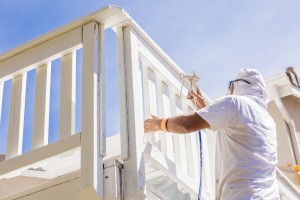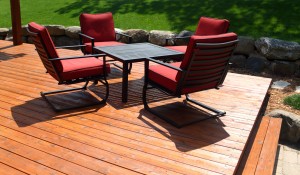The traditional wooden deck is a favorite of many people; they love the evenly placed planks dotted with rows of nails or screws. While some love the feel of solid-wood deck boards under their feet, some may even love the look of a weathered wooden deck. But these real wooden decks require a little bit of care from time to time. One of the most important maintenance choices you must make for your deck is whether you should go in for deck painting or deck staining. Except for some hard tropical hardwoods, all decks need some sort of finish to last outside. If you skip the finishing coat, it will usually lead to cracking, splitting, warping and even rotting of the wood.
Deck Painting
Painting your deck is a great choice and it has quite a few benefits over deck staining. But it is not for you if you love a natural looking wood deck.
Here are the pros and cons of deck painting:
Pros
- Painting gives the longest lasting protection against the elements. The high solid contents in paints help form a thick, opaque film on the surface that hide imperfections, resists moisture, and blocks UV rays.
- Painting gives you a wide range of options, because it allows you to use any color you want. Moreover, as the paint is solid, you can completely cover an old color or the wood itself.
- As the paint is thicker, it helps fill the gaps and cracks in the wood. Some paints are made to be used for repairing wood that has been damaged by the elements.
- Painted decks are easier to clean. If the paint used is of good quality and has been allowed to cure properly before put into use, it creates a hard shell that prevents dirt from staining. However, this depends on the color; white color painted decks are not easy to clean.
- Deck painting is a more protective option to the wood, because it resists rot, mold and sun damage.
Cons
- Painting is a messy job, as you have to prepare, preserve and prime the wood first.
- Paint is forever. Once you decide to paint your wood deck, you do not have any option to change it in future. You can change the color, but you cannot go back to deck staining.
- Painted decks can be slippery when wet. Depending on the sheen of the paint used (gloss, semi-gloss, etc.); painted decks can be as slick as ice when wet.
- Painting hides the natural beauty of wood. The color, grain pattern and texture of the wood are hidden by painting.
- A wood deck is exposed to sun, rain and snow, and the constant shrinkage and expansion of the wood causes paint to peel over time.
Deck Staining
Deck staining if for people who decide that painting is not for them. They will then probably end up with the transparent or semi-transparent stains. There are several types of stains; but there are still pros and cons while you choose to stain your deck.
Pros
- Staining helps retain the natural beauty of wood and it lets the wood grain, texture and color show through.
- Generally, stain is less slippery. Although there are some stains that can be slippery, most of the stains are more of a flat surface that protects the wood without creating a slippery surface.
- It is easier to apply stain. Even if you miss a spot here and there, it will not be obvious.
- Stains are available in a variety of colors. As the wood itself will have a big effect on the finished color of the stain, it is better to test an area of the deck with the stain before buying it.
Cons
- Stains have a shorter life span when compared with paints. The life span of stains depends on the quality, number of coats applied and the weather condition.
- Stains do not fill cracks. Generally, they are much thinner; so, they cannot be used as a repair material to fill cracks, splinters and voids.
Deck painting and deck staining both can give you a deck that lasts longer than an untreated deck. Paints and stains make the wood less water absorbent and keep it dry on the inside. They have compounds that protect the wood from harmful UV rays, which means less of sun damage.



buy papers online
1 year agocustom note paper https://premiumpapershelp.com/
order a paper
1 year agowhere to buy papers https://ypaywallpapers.com/
help writing paper
1 year agosomeone write my paper https://studentpaperhelp.com/
2lenders
1 year ago3leicestershire
design and technology gcse coursework
1 year agocoursework samples https://brainycoursework.com/
coursework only degree
1 year agocoursework writers https://courseworkninja.com/
do my coursework online
1 year agocoursework writing https://writingacoursework.com/
coursework paper
1 year agocourseworks help https://mycourseworkhelp.net/
creative writing english coursework
1 year agocoursework writer uk https://courseworkdownloads.com/
coursework service
1 year agocoursework https://courseworkinfotest.com/
courseworks help
1 year agocoursework service https://coursework-expert.com/
coursework history
1 year agocoursework masters https://teachingcoursework.com/
coursework
1 year agocreative writing coursework https://buycoursework.org/
coursework project
1 year agocoursework only degree https://courseworkdomau.com/
dafing sites
1 year agosingle dating sites free https://freewebdating.net/
dating service site
1 year agodate website free https://jewish-dating-online.net/
single personal ads
1 year agofree adult dating sites https://free-dating-sites-free-personals.com/
plentyoffish
1 year agodating chat site https://sexanddatingonline.com/
top online dating websites
1 year agosingle women online https://onlinedatingsurvey.com/
free sites of dating
1 year agomatchmeetups dating site https://onlinedatingsuccessguide.com/
dating websites for free
1 year agowhich is best online dating site https://onlinedatinghunks.com/
men dating sites
1 year ago100 free chat and dating for adults free https://allaboutdatingsites.com/
adult chat free
1 year agosingle date online https://freedatinglive.com/
dating web
1 year agodating sites free near me https://freewebdating.net/